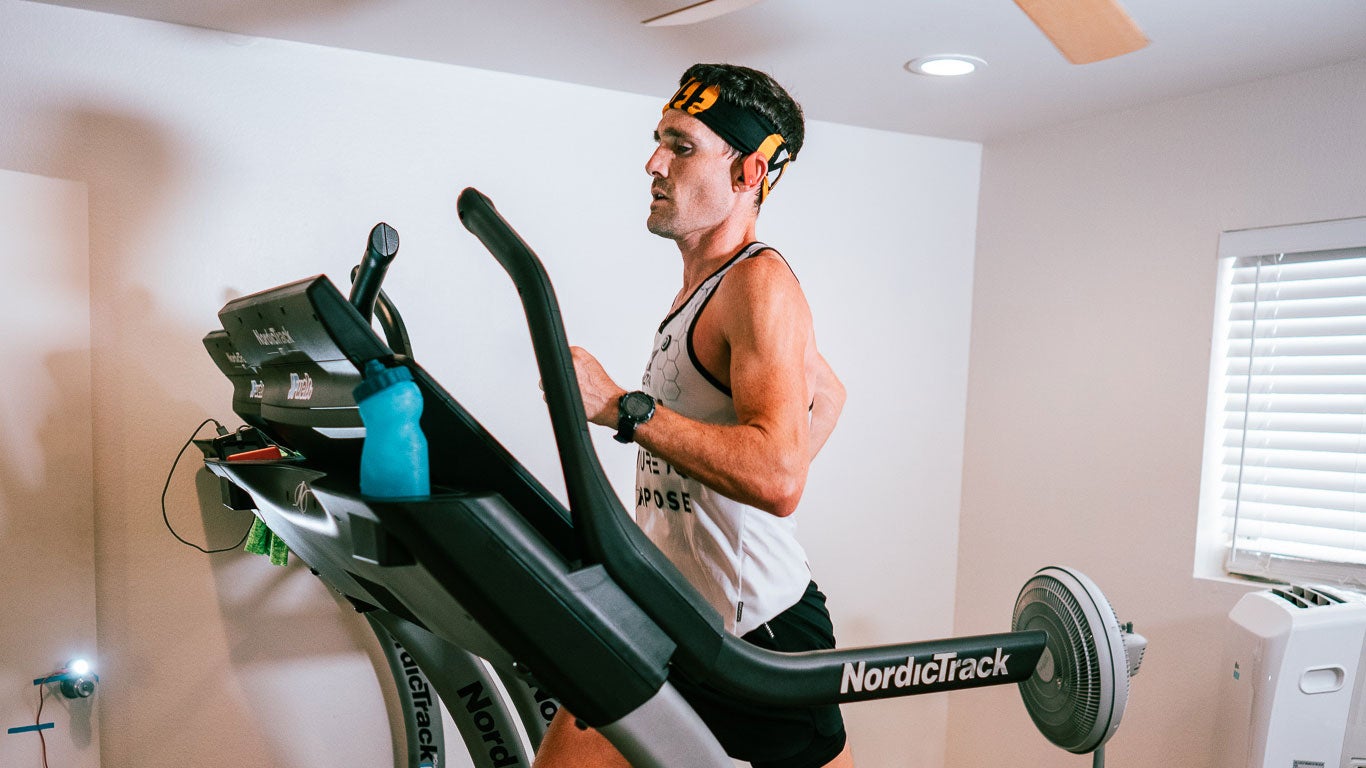Gearing Up for a Virtual Event? Get Inspired By This World Record Holder

Zach Bitter attempts to break the record for fastest 100 miles on a treadmill. (Photo: NordicTrack)
The Triathlete Challenge: At Home is just around the corner and undoubtedly, prepping for a virtual event requires you to think differently than you would for a traditional race day. In need of inspiration? Last weekend, record-breaking ultrarunner Zach Bitter ran 100 miles on his treadmill at home in Phoenix, Arizona; having previously never ran for more than 30 miles at one time on the belt.
Bitter smashed the existing world record for fastest 100 miles ever run on a treadmill: averaging a 7:18 pace over 12 hours, nine minutes and 15 seconds of running. (If you’re curious, he did it on this NordicTrack X22i.)
The week leading up to this mammoth effort looked fairly different to his usual routine, which presented both pros and cons.
Bitter’s nerves were amplified by the fact that hundreds of people (some even running along at home) were due to tune in on the day via a live stream, hosted by guests and comedians.
Bitter knew the time he had to hit—Canada-native Dave Proctor covered the virtual distance in 12:32 in 2019.
“Generally speaking, the week leading into a race I try to keep busy with as many non-physical and mentally tasking things, as it helps me to not fixate too much on the nerves,” Bitter said.
“Although I scale back on my training the days leading into the race, I did jump on the treadmill for some short runs at goal pace in order to practice what it would be like to finish the final miles. This tends to make it feel like I have done it a bunch of times already before the event,” he advised.
Bitter agreed that trying to stay in the moment while undertaking a virtual race is pivotal. As he put it, “When you start thinking too far ahead, it seems it will invite your mind to start asking questions you don’t want it to, like ‘How am I going to make it to 100 miles when I am only at mile 20?’”
“Breaking it into manageable blocks to check off helps me,” he said. “A strategy I used was to use a variety of paces around my target pace, so I wouldn’t be sitting on any one pace for too long. This helped me look forward to completing smaller goals throughout that day that ultimately add up to finishing.”
Visualization is something that Bitter relied heavily on; lending on all the training hours that had come before the pandemic and applying that to this unique scenario.
“This helps minimize the totality of race day,” he said. “When I had five hours left, I focused on how small five hours really is when compared to 20-hour training weeks and the time and energy required to put this together. When I focus on race day, it is a lot of visualization of where I would like to be throughout the day and how it will feel to have a strong performance.”
Bitter agreed it’s beneficial, but simultaneously jarring, doing a virtual effort at home.
“The nice part is you have an environment you’re familiar with. You eliminate travel logistics, sleeping somewhere different and eating foods you haven’t prepared and know work great for you,” he said.
“The hard part mentally is basically all the logistics fall on you. There is no built in event aid, volunteers, and medical. Mentally, I tried to remind myself it was just another event. It really helped to have my wife, an experienced ultramarathon runner, crewing and helping throughout the day.”
External motivation also came in the form of wanting to do sponsors and event organizers proud.
“There is definitely a degree of simply not wanting to let people down,” Bitter agreed. “One of my favorite aspects of this event was that it was simply bigger than just me.”
Ultimately, a lot of it does come down to mind over matter. Though Bitter recommends a strategic approach to the physical part too.
“I believe there’s value in training as specifically to race intensity and environment as possible in the weeks leading into the race, so spending a lot more of my training time on my treadmill helped me familiarize with the mechanics and mental task at hand,” he said.
“I always encourage endurance athletes to remind themselves before an event that in most cases there will be a point where your mind begins giving you seemingly good reasons to stop or slow down. There are definitely limits, but when these start it is rarely something you cannot push through.
“At the end of the day, in events like ultramarathon and triathlon that take so long to complete, the days you are most proud of and achieve your best performances are usually the ones where you are able to push through a few more of these mental blocks during the later stages of the event. Knowing this and visualizing this going into the event can better prepare you to catch those moments and respond when it happens on the day of the event.”